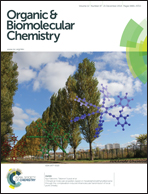Phosphonated chelates for nuclear imaging†
Abstract
A series of bis-, tris- and tetra-phosphonated pyridine ligands is presented. In view of their potential use as chelates for radiopharmaceutical applications, the physico-chemical properties of the ligands and of their Co(II), Ni(II), Cu(II), and Zn(II) complexes were studied by means of potentiometry and UV-Vis absorption spectroscopy. The pKa values of the ligands and of the complexes, as well as the stability constants for the formation of the complexes, are presented. The kinetic aspects of the formation of Cu(II) complexes and of their dissociation in acidic media were studied by means of stopped flow experiments, and the stability of the Cu(II) complex toward reduction to Cu(I) was investigated by cyclic voltammetry and by titration with different reducing agents. The different thermodynamic and kinetic aspects of the polyphosphonated ligands were compared with regard to the impact of the number of phosphonic acid functions. Considering the very promising properties for complexation, preliminary SPECT/CT imaging experiments were carried out on mice with 99mTc using the bis- and tetra-phosphonated ligands L2 and L1. Finally, a bifunctional version of chelate L1, L*, was used to label MTn12, a rat monoclonal antibody with both specificity and relatively high affinity for murine tenascin-C. The labeling was monitored by MALDI/MS spectrometry and the affinity of the labeled antibody was checked by immunostaining experiments. After chelation with 99mTc, the 99mTc-L*-MTn12 antibody was injected into a transgenic mouse with breast cancer and the biodistribution of the labeled antibody was followed by SPECT/CT imaging.


 Please wait while we load your content...
Please wait while we load your content...